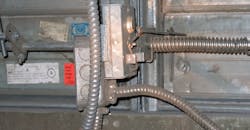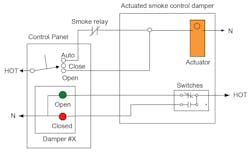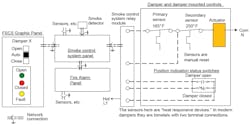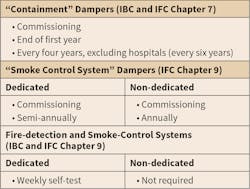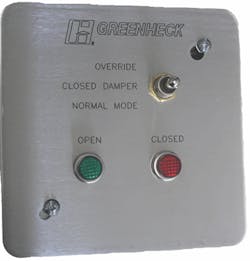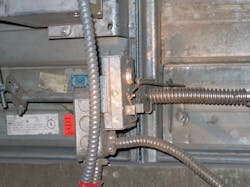Remote Fire- and Smoke-Damper Testing Nears
By LARRY FELKER, Belimo Americas
A specialist in fire and smoke dampers and actuators, the author is fire- and smoke-product manager for Belimo Americas. He is vice chair of Air Movement and Control Association (AMCA) International’s Fire and Smoke Damper Task Force, a member of the International Code Council, the National Fire Protection Association, and the Society of Fire Protection Engineers, and a life member of ASHRAE. He is co-author of the book “Dampers and Airflow Control,” published by ASHRAE Special Publications in 2010.
Periodic testing of fire and smoke dampers and associated controls is required by codes to ensure the devices will function as designed if/when needed. The International Building Code (IBC)1 and International Fire Code (IFC)2 establish frequency requirements (Table 1). NFPA 80, Standard for Fire Doors and Other Opening Protectives,3 and NFPA 105, Standard for Smoke Door Assemblies and Other Opening Protectives,4 detail testing requirements. At present, the standards require visual verification of life-safety-damper operation. The 2019 editions of the standards, however, will allow remote automated testing.
Remote-Testing Hardware and Software
Figure 1 shows basic wiring for a remotely tested smoke damper. When the damper is open, the green light is on; when it is closed, the red light is on. In Auto mode, the smoke-control-system relay manages the damper’s position. The Close and Open manual switches can be used to override the damper, while the position lights can be used to determine the damper operated.
In an IBC Chapter 7-required damper, a smoke detector or relay from an area smoke-detection system is employed for automatic control. Override and position indication are not required. In an IBC Chapter 9-required damper, override and position indication are mandatory, and the connections are to the firefighters-smoke-control-system (FSCS) panel.
Figure 2 shows a networked system. The damper is a combination fire and smoke damper re-openable from the FSCS panel. Instead of hardwired connections, as in Figure 1, the alarm/smoke-control-panel network is used to carry digital signals. The panel display is the same in both systems.
Connections can be hardwired or networked. The central control can be a dedicated microprocessor-based panel, an alarm and smoke-control panel, or a UL 8645 UUKL-listed building-automation system. The software for automatic testing resides in the smoke-control system. It sets times and fan shutdown during testing, if needed, and generates an exception report if any defects are found.
Costs and Payback Periods
The installed cost of a network-module testing system or an actuator designed for testing is an estimated $200 per damper.
The outside-labor cost of visually inspecting and testing a damper varies with the number of dampers being tested and the market labor rate. Building age and occupancy also are important. For example, if asbestos is present, protective containment will be necessary when a ceiling is opened. Inspection and testing of a smoke or a combination fire/smoke damper is assumed to range from $50 to $100 per damper.
TABLE 1: Periodic testing requirements.6
While commissioning/conformance testing should be performed visually, followup testing can be performed remotely at little or no cost. The simple-payback period for containment-damper testing per Chapter 7 of the IBC ranges from four years to 12 years ($200/$100 = two tests, years 1 and 4; $200/$50 = four tests, years 1-12). Certainly, a 25% return on investment (ROI) is attractive; an 8% ROI is not as attractive, unless other benefits, such as prevention of mold or fungal spread from opening ceilings, more assured and more frequent testing, and added life safety, exist.
Remote testing of dampers installed per Chapter 9 of the IBC has an immediate payback. Because override and position indication are required for smoke-control-system dampers (figures 1 and 2), controls required for remote testing must be installed per code.
Manual control of dampers from FSCS panels already is possible. See the FSCS graphics panel display in Figure 2; this can be used to test a damper. If a damper is dedicated to smoke control, two tests are required annually (Table 1), for an estimated savings of $50 to $100 the first year and $100 to $200 each year thereafter (calculated using $50 to $100 per damper and one to two tests per year). Instead of the cost of visual inspection, dampers can be closed and opened from a FSCS panel and indication lights monitored for correct indication. When the 2019 editions of NFPA 80 and NFPA 105 are adopted, this will meet the requirements for periodic testing.
Testing Inaccessible Dampers
Dampers often are buried behind ducts or are in otherwise difficult-to-reach places. Remote testing offers a major benefit in such cases. Figure 3 shows a discrete position-indication light assembly for damper testing. Such assemblies can be added in the field for existing dampers or specified by consultants for new projects.
Local wiring can be run to indication panels. A panel can be placed on a wall or in an equipment closet. Figure 4 shows wiring for a remote indicator. Switches can be of the damper-blade or actuator-auxiliary variety; either is permitted by codes.
A damper moving to the open or closed position upon command and returning to operation is the proof required. NFPA 80 and NFPA 105 do not specify the method used to confirm damper position. This could be demonstrated through sound, light through the damper blades, actuator drive time with current readings, actuator software switches, actuator potentiometers, or even cameras and LEDs inside the damper assembly. Only switches are time-tested, and their cost is the lowest.
While Figure 4 shows a smoke damper, fire dampers can be actuated as well. Many curtain dampers are buried in walls behind ducts or grills and are inaccessible. An actuated fire damper allows remote testing.
Ease of Testing
Whether a local indicator panel or a FSCS graphics panel is used, testing will be simplified. Maintenance personnel can observe the light indication on local panels; for IBC Chapter 7 containment dampers, red is bad, and green is good. IBC Chapter 9 dampers must be connected to a FSCS panel; while some normally are closed, testing is just as simple.
Deferred maintenance is less likely with remote testing, as failure of an actuator results in a red “closed” light or LED indication. Maintenance staffers have little choice but to address any such problems.
Increasing Safety
Remote testing increases safety in several ways:
A. Problems can occur between periodic tests: Ducts can shift with seismic activity, corrosion can build up, and unexpected work above ceilings can result in hidden defects. With remote testing, dampers can be tested more frequently.
B. Remote damper testing reduces the need to breach ceiling membranes, which is of particular concern in health-care facilities. Breaches potentially expose patients and staff to infectious diseases or asbestos.
C. Remote testing reduces hazards to maintenance technicians, who do not need to climb on ladders to reach difficult-to-access areas. The need for lifts and containment equipment is avoided.
Control Reliability
Remote testing is more reliable than visual inspection after four (or six) years. Assuming auxiliary switches are employed, the absence of an indicator light is cause for a maintenance check.
The components used for remote indication—switches inside actuators, blade switches, magnetic switches—are well-known for being simple and reliable.
UL thoroughly tests dampers and actuators, including switches. UL 555S, Standard for Smoke Dampers,7 requires dampers and actuators to be subjected to a six-month holding test and cycled 20,000 times (plus 100,000 10-degree movements, if modulating). Dampers and actuators are subjected to fire, hose-stream, salt-spray, and drop tests. A damper and actuator together are heated to 250°F or 350°F for a half-hour and subjected to the same elevated temperature for 15 minutes at 2,400 fpm and must close and open properly. Then, they are turned around, and the test is repeated with airflow in the opposite direction. Finally, there is an air-leakage test. The damper blade and actuator auxiliary switches are checked for operation and electrical continuity.
Whether actuator, damper-blade, or magnetic switches are used, the make and break points are not always precise enough to catch a 1- or 2-degree open gap when a damper should be closed. And neither are most technicians. Some external switches on certain older actuators shift with repeated operations.
Modern direct-coupled actuator clamps are cold-welded to damper shafts. When tightened, they make slipping nearly impossible. Once actuator switches are set and, if necessary, adjusted during field acceptance, they are not going to shift.
After decades of service, many switches continue to perform. Photo A shows a blade switch still functioning after 30 years. For this article, one manufacturer went through 15 years of data and found only two switch failures.8 Another manufacturer’s ISO 9001 records for actuator-switch failures over the last five years show two failures—out of 500,000 switch models sold in the United States.9
While a few dampers may not close 100% and provide Class 1 leakage performance, they still close to prevent most smoke and fire from passing and potentially still provide Class IV leakage performance. Those that are not inspected, or tested and sometimes fastened open, provide no protection at all.
Conclusion
While manual inspection and testing likely will remain the primary method of ensuring damper operation, remote testing is a reliable way to approach the need for inspections. Use of proven remote-testing technology can avoid cost and increase safety.
References
1) ICC. (2015). International building code. Country Club Hills, IL: International Code Council.
2) ICC. (2016). International fire code. Country Club Hills, IL: International Code Council.
3) NFPA. (2016). Standard for fire doors and other opening protectives. NFPA 80. Quincy, MA: National Fire Protection Association.
4) NFPA. (2016). Standard for smoke door assemblies and other opening protectives. NFPA 105. Quincy, MA: National Fire Protection Association.
5) UL. (2014). UL standard for safety control units and accessories for fire alarm systems. UL 864. Northbrook, IL: UL.
6) Felker, L. (2014, October). Codes & damper testing. ASHRAE Journal, p. 76.
7) UL. (2014). Standard for smoke dampers. UL 555S. Northbrook, IL: UL.
8) Personal communications. Greenheck Fan Corp., Schofield, WI.
9) Company records examined by author. BELIMO Automation AG, Hinwil, Switzerland, and Belimo Americas, Danbury, CT.
